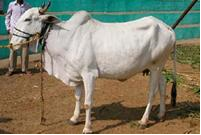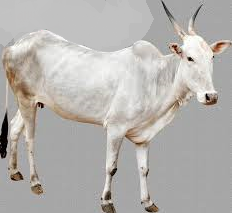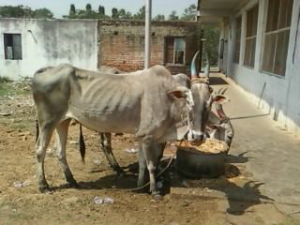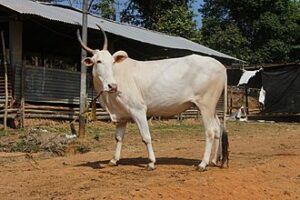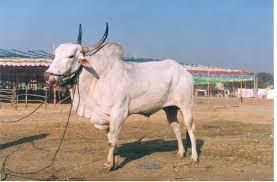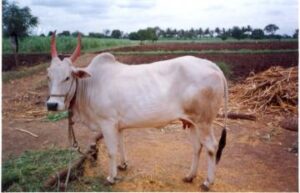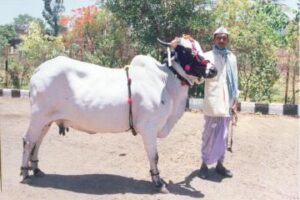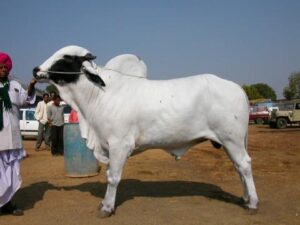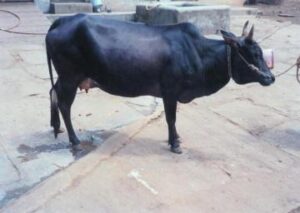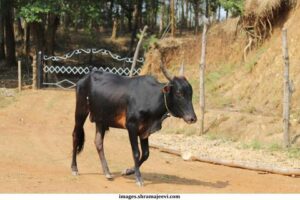Cattle Breeds of Karnataka
1Ratnaprabha M.B., *2Vidyasagar, 3Biradar Satish Chandra,
Department of Livestock Production and Management
Veterinary College, Nandinagar, Bidar.
*Email id: vsgr00@gmail.com
Introduction: India has 50 cattle breeds among these Karnataka is having some important breeds such as Deoni, a Dual-purpose breed, Amritmahal, Hallikar, Khillari, Krishna Valley and Malnad Gidda, a draught purpose breeds.
- Amritmahal
Synonyms: Kavalu Dana, Number Dana, Jawari Dana
Amritmahal Cattle Breed: The breed was developed by the ruler of Mysore state (1572-1636 AD) using Hallikar, Hagalvadi and Chitaldoorg breeds of southern India.
Breeding tract: Chikmagalur, Chitradurga, Hassan, Shivamogga, Tumkur and Davanagere Districts of Karnataka.
Amrithmahal Bull Amrithmahal Cow
Phenotypic characteristics
The breed is usually grey in color but the color varies from white to almost black. In some animals white grey markings are present on face and dewlap; Muzzle, Switch and feet are usually black in colour. Head is long and has a tapering muzzle and forehead is prominent with a furrow in the middle. Horns are long and emerge from the top of the poll, fairly close together in backward and upward direction, turn in and end in sharp black points – sometime touching each other. These are medium sized animals with compact body and long legs. They have well arched short ribs and strong quarters. They have tight skin and thin dewlap. They also have very bright bloodshot eyes.
Utility: This is a famous draught breed known for its power and endurance. Bullocks are especially suited for trotting and quick transportation.
Production performance: Cows are very poor milkers. Average milk yield per lactation is 572 kg.
- II. Hallikar
Hallikar cattle breed: Hallikar cattle breed is known as “Mysore” cattle breed. The animals are maintained in semi-intensive management system.
Habitat: These cattle are bred mainly in the Tumkur, Mysore, Mandya, Bengaluru, Kolar, Hassan and Chitradurga districts of Karnataka. These represent a very definite type, varieties of which differing in general type only slightly from each other, are found throughout Mysore territory and adjoining areas of neighboring states.
Hallikar Cow Hallikar Bull
Phenotypic characteristics:
These cattles are of medium size, compact and muscular in appearance, with strong legs. And the face is long with prominent forehead and small ears. The coat colour of the breed is white to light grey with darker shadings on fore and hind limbs. And light grey markings on the face, dewlap and under the body. These are having fine skin and glossy coat. Horns emerge near each other from top of poll and are carried straight, upward and backward, till nearly half the length and then orient slightly forward and inward with pointed tips. Horns are black and sharp. White markings or irregular patches around the eyes, cheeks, neck or shoulder region are also seen and hump is moderately developed.
Utility: The breed is considered as best draught breed useful for both road and field work. Bullocks are strong, spirited, quick and steady workers. Cows produce very little milk.
Production performance: The average milk yield per lactation is 542 kg and average milk fat percentage is 5.7%.
III.Khillar
Synonym: Thillari, Tapi, Khillari
Khillar cattle breed: The breed is also known as “Mandeshi”, “Shikari” and “Thillar”. This breed is developed from Hallikar or Amritmahal breed of cattle. The gait of Khillar is quick and spirited.
This breed was reared by professional breeders known as “Khillaris hence the name is Khillar”.
Breeding tract: The Breed originated form Belgaum, Bijapur, Dharwad, Gulbarga, Bagalkot districts of Karnataka and Pune, Satara, Sangli, Solapur, Kolhapur, Osmanabad districts of Maharashtra.
Khillar Cow Khillar Bull
Phenotypic characteristics:
Four types of Khillar cattle are prevalent in different parts of the country: “Atpadi Mahal” in Southern Maharashtra; “Mahaswad” in Solapur and Satara area; “Thillari” in Satpura range of hills; “Nakali” in adjoining area of this region.
Khillar cattle of Deccan plateau – the “Mhaswad” and the “Atpadi Mahal” this is the longest Khillar type and these are greyish-white in colour. Males are having dark colour over the fore and hindquarters with peculiar grey and white mottled marking on face. The “Tapti Khillar” is white with pink nose and hooves (carrot color) while Nakali is grey in colour and brick dust color on the fore limbs.
The typical Khillar animal is having comparatively long body with well arched ribs; convex face with prominent forehead; the whole appearance is like a compact cylinder with stout, strongly set limbs. These are having small and predominant eyes and pointed small ears. They are having smooth and tight skin. Horns are long and pointed and follow the backward
curve of the forehead which are placed close together at the root with thick base, grow backward for half of the length and then turn upwards in a smooth bow shape ending in
pointing tips. Hump is well developed placed in front of wither; well developed dewlap and short tail with black switch. There is a slight rise in the level of the back towards the pelvis.
Utility: Bullocks are highly valued as fast powerful draught animals. These are suitable for both field and road work. Cows are poor milkers.
Production performance: The average milk yield per lactation is 451 kg with an average fat percentage is 4.2
- IV. Krishna Valley
Krishna Valley breed: This breed is extensively used in the black cotton soil areas of Krishna River and its tributaries such as Ghataprabha and Malaprabha . The breed is also known as “Kistna Valley”. It is believed that the Gir and Kankrej breeds of Gujarat, Ongole breed of Andhra Pradesh and local cattle of Mysore type blood, have contributed to the origin of this breed.
Breeding tract: The breeding tract of the breed includes Belgaum, Raichur, Bagalkot, Dharwad and Bijapur districts of Karnataka and southern parts of Maharashtra and Telangana states.
Krishna Valley Cow Krishna Valley Bull
Phenotypic characteristics:
The common color is grey, white with a darker shade on forelimb and hind limbs in males. The adult females are more whitish in appearance or Brown & white, black & white, and mottled colors are often seen. Long and Massive body, deep and broad chest; short powerful neck and straight limbs; small head with bulging on forehead (concave) are the unique characteristics of this breed. Eyes are large and dark gives docile expression. Horns are small in size and curved and usually emerge in an outward direction from the outer angles of the
poll curving slightly upward and inward. Well developed hump place in front of withers; moderately developed sheath and small pointed ears which are black inside, dewlap is well developed and tail is of moderate length with black switch. Hooves are soft. In generally Krishna valley animals are heavy and massive and give a lethargic appearance.
Utility: Bullocks are very powerful animals used for draught purpose or used for ploughing.
- Deoni
This breed has inherent resistance to deadly tropical diseases, good adaptability to harsh and hot humid environmental conditions, and endurance to agriculture operations.
Deoni cattle breed: The breed is also known as “Surti”, “Dongarpati”, “Dongri”, “Wannera”, “Waghyd”, “Balankya” and “Shevera”. It is a believed to be developed from a strain descended from the mixture of Gir, Dangi and local cattle. The breed developed its name from the place of origin i.e., Deoni taluk of Latur district in Maharashtra
Home tract: The actual place of origin is Deoni, Udgir and Ahmadpur taluks of Latur district. The breeding tract of this breed is Balaghat range of Sahyadri hills extending from Kannad taluk of Aurangabad to Deglur taluk of Marathwada region of Maharashtra state and these are also found in Bidar, Gulbarga, Chitradurga district of karnataka state.
Deoni Cow Deoni Bull
Phenotypic characteristics:
Body colour is usually spotted black and white; This breed has three strains viz. Balankya (complete white), Wannera (complete white with partial black face) and Waghyd or Shevera (black and white spotted). Well built medium sized body, prominent bulged forehead with bright alert eyes with black eyebrows and black eyelashes; these are having long droopy ears; Wide and deep chest with straight top line; legs are straight and strong; have strong black hooves. Small sized horns emerge from the side of the poll behind and above the eyes in outward and upward direction. The tips of the horn are blunt; thick and loose skin and has
pendulous and hanging dewlap, have well developed udder with black teats. Deoni bullocks are preferred for heavy works and bullocks can effectively be used even up to 12 years of age.
Utility: Dual purpose
Production performance: The average milk yield per lactation of Deoni is 868 kg (ranging between 638 to 1229 kg) with an average milk fat of 4.3 (ranges from 2.5 to 5.3 %)
- Malnad Gidda
Malnad Gidda cattle breed: It is the Non descript cattle of western Ghats and coastal regions of Karnataka. This breed is also known as “Gidda”, “Uradana” and “Varshagandhi”. “Malnad” means hilly region a place with heavy rainfall and “Gidda” means small or dwarf. These are well adapted to the local agro-ecological systems of Western Ghats.
Breeding tract: The breeding tract of this breed includes Chikmangalur, Hassan, Kodagu, Shivamogga, Dakshin Kannada, Uttar Kannada and Udupi districts of Karnataka.
Malnad Gidda Cow Malnad Gidda Bull
Phenotypic Characteristics:
The predominant coat colour is brown or black with light shades of fawn on thigh and shoulder region. Horns are generally small, straight, outward, upward and inward. They are small with compact body frame and adult animals are around 90 centimetres tall and have short legs. Tail switch is black in colour, eyelashes, horns and hooves will be black in colour. Well defined Hump, udder is small and bowl shaped, Malnad Gidda cattle are reared under low input low output system. In some areas, it is zero input system where animals sustain solely on grazing
Utility: They play a major role in the rural economy of this region by providing milk, manure and draft power with negligible inputs.
Production performance: Elite cows give 3-5 kg of milk per day and the average lactation yield is around 220 Kg.
https://ahvs.kar.nic.in/breeds.htm
https://www.pashudhanpraharee.com/cattle-breeds-of-karnataka/hallikar-cow/




